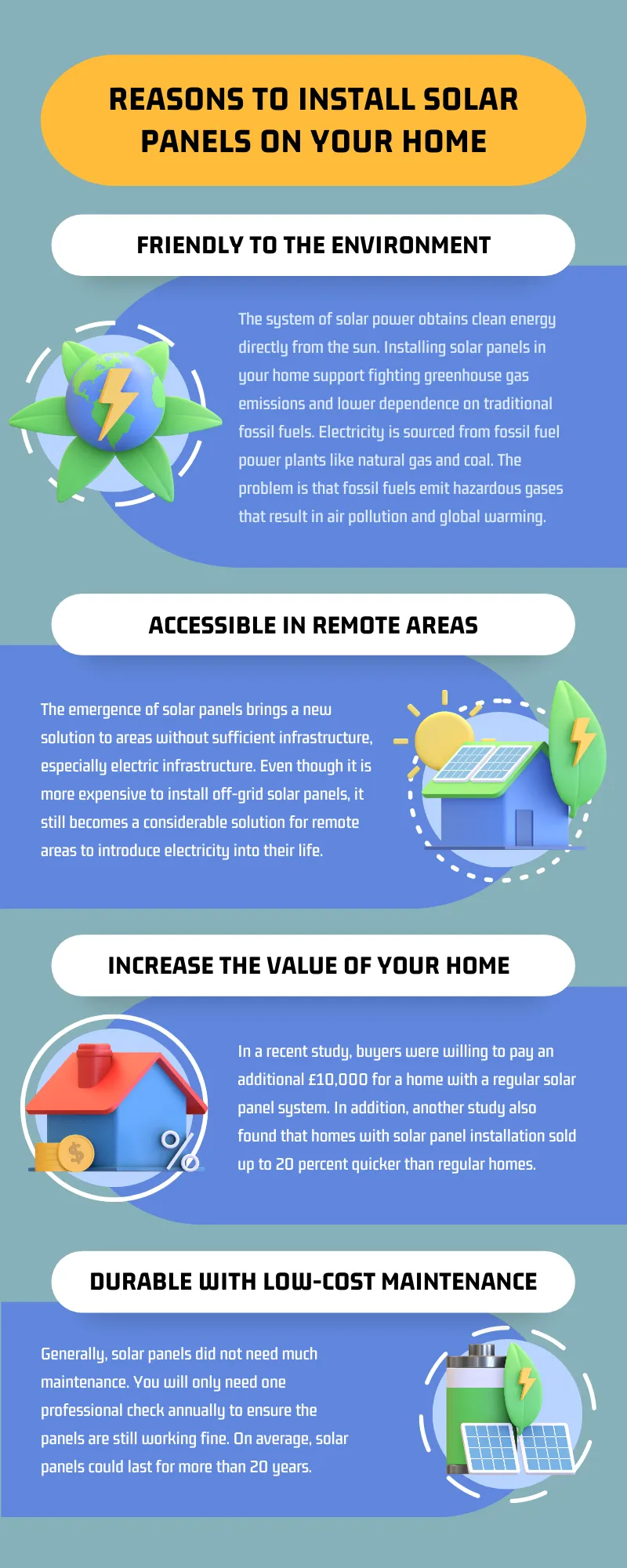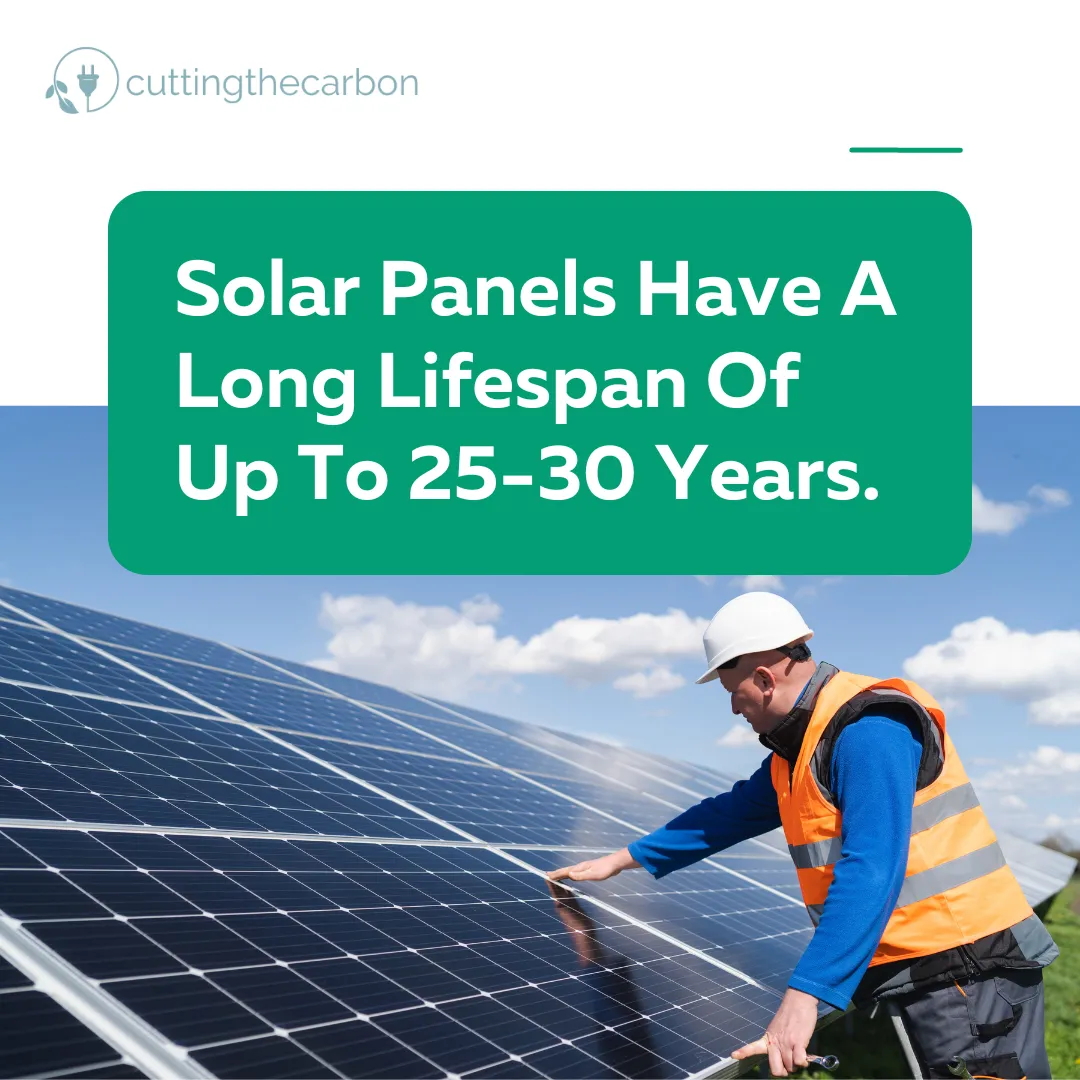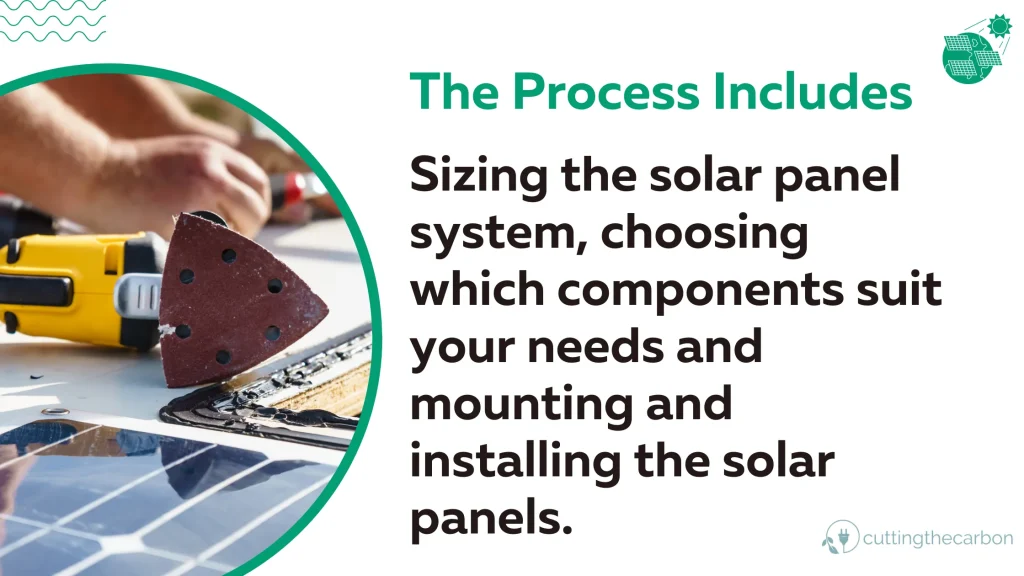Are you interested in the idea of installing solar panels on your home and taking control of your energy needs? You’re not alone.
Many homeowners turn to DIY solar panel installation as an empowering and cost-effective solution.
But can you install solar panels yourself? Is it really as simple as it sounds?
In this comprehensive guide, we will walk you through everything you need to know about DIY solar panel installation in the UK, from understanding the process to navigating building regulations and permissions. Let’s embark on this electrifying journey together.
Short Summary
- Install solar panels yourself and save up to £2,000 with the right preparation and knowledge.
- Consider the potential risks of DIY installation before starting a project.
- Hire a professional installer for safe and efficient results.
Understanding DIY Solar Panel Installation
Installing solar panels on your own can be a thrilling and rewarding experience, allowing you to tap into the power of the sun and save money on your energy bills.
It’s an opportunity to take charge of your energy needs and positively impact the environment.
But before diving into the world of DIY solar panels, it’s essential to understand the process and the factors to consider before attempting installation diy solar power system.
By installing solar panels yourself, you’ll be responsible for calculating your energy usage, researching peak sun hours, sizing your solar panel system, and sizing your battery storage.
These are crucial steps to ensure that your solar system is tailored to your specific needs and can generate enough electricity to power your home efficiently.
It’s important to weigh the benefits and drawbacks of DIY solar panel installation, such as cost savings and pride in completing the project, against potential safety risks and long-term costs.
To guarantee the success of your installation and the safety of your roof, consider having a professional surveyor assess your roof and rafters before installation.
Here Is A Summary Of The Steps Involved In A DIY Solar Panel Installation:
| Step | Description |
|---|---|
| Step 1: Calculate Your Daily Energy Usage | Buy all the required parts for your installation, including solar panels, charge controllers, solar batteries, solar inverters, connectors, fuses, and other accessories. |
| Step 2: Design Your System | Decide if you want to substitute all or part of your daily energy usage with solar power. |
| Step 3: Size Your Solar Panels | Calculate how many solar panels you need to produce the desired amount of power. |
| Step 4: Purchase Quality Solar Components | Buy all the necessary parts for your installation, including solar panels, charge controllers, solar batteries, solar inverters, connectors, fuses, and other accessories. |
| Step 5: Install Your Railings, Mounts, and Components | Prepare the areas where you will install your components and then install the components. |
| Step 6: Connect your solar to your home’s distribution box | Decide which circuits you want to power with solar power and join or replace the wires with the power supply of your choice. |
Is it possible to install solar panels yourself?
The short answer is yes. You can take on the challenge of installing your own solar panels and experience a sense of accomplishment.
However, knowing the potential risks involved in DIY solar panel installation is important. While the likelihood is low, DIY installations could result in a shorter lifespan and a lack of warranty coverage for your solar panels. Additionally, be cautious of scams offering paid DIY tutorials or selling substandard panels.
Installing solar panels requires a certain level of electrical expertise and can be time-consuming, so ensure you’re prepared before starting.
While there are advantages to leaving the solar installation to a professional, such as their expertise in the complex process of solar installation, there’s no denying the excitement of taking on the challenge yourself.
However, knowing the potential risks of DIY installation and solar installers, including incorrectly connected and fitted systems, is crucial. By being well-informed and prepared, you can minimize these risks and ensure the success of your DIY solar project.
How to Install Solar Panels In The UK – A Complete DIY Video Guide
Factors to consider before attempting DIY installation
Before embarking on your DIY solar panel journey, it’s crucial to consider several factors. First, ensure that your roof is in excellent condition and robust enough to support the weight of the solar panels.
Next, carefully weigh the initial cost of solar panels against the potential long-term savings solar panel generates you on your energy bills.
Finally, recognize the importance of professional experience in solar panel installation to guarantee that the system is accurately and securely installed. By considering these factors, you’ll be better equipped to decide whether DIY solar panel installation is right for you.
Cost Comparison: DIY vs Professional Installation
When it comes to solar panel installation, one of the main factors that homeowners consider is the cost. DIY solar panels can provide immediate savings, but professional installation may be more cost-effective in the long run when considering potential hidden costs and risks.
The cost of DIY installation can vary significantly depending on several factors, such as the size of the system, the type of installation, and the choice of installer. By tackling the design and labour costs yourself, you can save up to 90% of the average cost of a solar panel installation.
On the other hand, professional installation includes the cost of all components plus approximately 10% of the cost of components for labour. With professional installation, you can be assured of a solar panel system that lasts 20-30 years and is usually covered by a warranty.
Ultimately, the most cost-effective solution will depend on your specific situation and the potential hidden costs and risks associated with DIY installation.
Saving money with DIY solar panels
By embarking on a DIY solar panel project, you could potentially save around £2,000 based on the average cost of professional solar kit installation. However, the actual cost savings will depend on several factors, such as the size of the system, the cost of materials, and the cost of professional installation.
To maximize your cost savings, consider various factors like the size of the system, the cost of materials, and the cost of professional installation.
While DIY solar panel installation can be a great way to save money, it’s essential to be aware of the potential risks and hidden costs.
Additional materials or labour costs could add up, so planning and budgeting are crucial. By being well-informed and prepared, you can maximise the financial benefits of DIY solar panel installation while minimizing potential risks.

Comparing Rigid and Flexible Solar Panels: A Brief Overview
Rigid solar panels offer robustness, weather resilience, and the ability to fine-tune for maximum solar exposure, but their weight and need for roof drilling can be drawbacks.
In contrast, flexible panels provide lightness, versatility for different surfaces, and a simpler, drill-free installation, but they come at a higher cost and offer less durability.
The decision between the two hinges on your vehicle’s characteristics intended usage area, and financial considerations. This helpful guide answers many of the most commonly asked questions.
Hidden Costs and Risks of DIY Installation
While the potential cost savings of DIY solar panel installation are attractive, it’s important to consider the potential risks and hidden costs. Improper installation can result in safety hazards, decreased efficiency, and costly repairs.
In addition, there may be hidden costs, such as annual maintenance, inspections, storage or battery backups, and potential issues with insurance and mortgages.
By carefully weighing the potential benefits and drawbacks of DIY solar panel installation, you can decide whether it’s the right choice for you.
Steps to Installing Your Own Solar Panels
Now that you’ve weighed the pros and cons of DIY solar panel installation let’s dive into the steps involved in installing your own solar panels. From assessing your energy needs to choosing and purchasing components and finally to system installation and connection, installing solar panels can be an exciting and rewarding journey.
By following these steps, you’ll be well on your way to harnessing the sun’s power and taking control of your energy needs. To ensure the success of your DIY solar panel installation, it’s crucial to follow each step carefully and thoroughly.
This includes knowing your daily energy usage and the number of peak sun hours in your area, calculating the total power output needed from your panels, and determining the number of panels at each wattage you need to purchase to meet the demand.
By taking the time to research solar quotes and plans, you’ll be better prepared for the challenges of installing your own solar panels and reaping the benefits of renewable energy.
Assessing your energy needs
To determine your energy needs, start by analyzing your utility bills. Locate the Wh (watt-hours) or kWh (kilowatt-hours) used for each month on your bill and use the bills from the last three months to calculate your average monthly usage.
Calculate the total energy used within a month. Divide this figure by the total number of days in that month to determine your daily usage. This will give you an accurate picture of your energy consumption and help you size your solar panel system accordingly.
Next, research the daily peak sunlight hours for your area. You can find this information online or contact your local energy provider for more detailed information.
By understanding your daily energy use and peak sunlight hours, you can accurately size your solar panel system and ensure it generates enough electricity to meet your needs.
Choosing and purchasing components
Knowing your solar power amount requirements is essential when it comes to determining the number of solar panels you need. With this information, you can confidently calculate the exact amount of solar panels you need to generate the desired power output.
In addition, you’ll need to size your battery storage to store excess energy generated by the solar panel system, ensuring that you get the most out of your DIY solar panel installation.
Keep in mind that the components you choose will impact the overall cost and efficiency of your system, so it’s essential to carefully weigh your options and select high-quality components that fit within your budget.
System installation and connection
With your energy needs assessed and components purchased, it’s time to install and connect your solar system. Start by setting up the scaffolding and securing the solar panels on the roof with anchor points fixed to the loft rafters for optimal stability and reliability.
Carefully place the solar panels onto the mounting system before fully securing them, ensuring they are positioned at the ideal angle for maximum direct sunlight and exposure.
Next, connect the solar battery to the inverter, transforming the DC electricity generated by the solar panel into AC electricity. Finally, connect the inverter to the consumer unit to enable the electricity to energize your entire home.
By following these steps, you’ll be well on your way to enjoying the benefits of your DIY solar panel installation.

DIY Solar Panel Kits: Pros and Cons
Solar panel kits are an exciting option for those looking for an even simpler approach to DIY solar panel installation. These kits have all the necessary components to get started, including rigid solar panels, charge controllers, and cabling.
They can be a great choice for smaller projects like converting an RV or shed but may not be the best fit for a full-sized home.
Let’s explore the pros and cons of DIY solar panel kits to help you decide if they’re the right choice for your project.
DIY solar panel kits offer great convenience and cost-efficiency, as they come with all the required components and can be installed quickly. Plus, they offer more flexibility than pre-made solar panels, allowing you to tailor your system to your specific needs.
However, DIY solar panel kits also come with limited warranties and can be difficult to install for larger systems, which can present challenges for those without the right knowledge and skill set. Ultimately, deciding to use a DIY solar panel kit will depend on your individual needs, budget, and expertise.
Benefits of using DIY solar panel kits
One of the primary benefits of using DIY solar panel kits is the potential cost savings. Installing your own solar panels saves labour and materials, resulting in a more affordable and eco-friendly energy solution.
Moreover, DIY solar panel kits offer you the opportunity to have increased control over your energy needs, allowing you to tailor your system to your specific requirements.
Additionally, DIY solar panel kits are a great option for small projects, as they come with all the necessary components and are easy to install.
This makes them an ideal choice for those looking to make solar systems to power a shed, RV, or other off-grid applications, as well as those who want to dip their toes into the world of solar energy without committing to a full-scale installation.

Drawbacks of using DIY solar panel kits
While DIY solar panel kits offer several benefits, it’s also important to consider the potential drawbacks. For one, DIY solar panel kits typically come with limited warranties, which could pose an issue in the event of any problems with the system.
Additionally, installing a DIY solar panel kit requires a certain level of expertise to ensure its success. Improper installation can lead to inefficiencies, potential damage to the system, and even safety hazards like electric shock or fire.
As a result, it’s essential to weigh the pros and cons of using DIY solar panel kits and consider whether professional installation may be a more suitable choice for your specific needs.
Navigating Building Regulations and Permissions
When planning your DIY solar panel installation, it’s crucial to consider building regulations and permissions. Solar panel installations must adhere to building regulations, and evidence of compliance must be presented to the local authority.
While planning permission is generally not required for roof-mounted solar panels, some exceptions and conditions apply depending on the location.
By familiarizing yourself with the relevant regulations and permissions, you can ensure your solar panel installation is safe, compliant, and hassle-free.
To comply with building regulations, you must ensure that your roof is strong enough to support the solar panels, take steps to mitigate fire risk, improve ventilation, prevent moisture entry, and securely mount components.
Additionally, it’s important to obtain any necessary permissions and provide evidence of compliance to the local authority, such as a building permit or inspection report.
By taking the time to research and adhere to building regulations and permissions, you can have confidence in the safety and success of your DIY solar panel installation.
Understanding building regulations
To ensure the safety and success of your solar panel installation, it’s essential to comply with building regulations. These regulations cover a range of factors, such as roof strength, fire risk mitigation, ventilation, moisture prevention, electrical safety, and secure mounting of components.
By familiarizing yourself with these regulations and taking the necessary precautions, you can guarantee that your solar panel installation is safe, efficient, and compliant with local building codes.
Obtaining necessary permissions
In most cases, installing roof-mounted solar panels falls under “permitted development rights,” meaning you don’t need to apply for planning permission.
However, some exceptions and conditions apply depending on your location, so you must check with your local authority to ensure that you comply.
By obtaining the necessary permissions and providing evidence of compliance to the local authority, you can ensure that your solar panel installation proceeds smoothly without any legal hiccups.
Safety Concerns and Potential Issues with DIY Solar Panels
While DIY solar panel installation can be an empowering and cost-effective solution, it’s important to be aware of the potential safety concerns and issues that can arise.
Improperly installed solar panels can cause fires, damage roofs, and reduce the system’s lifespan. As a result, hiring a professional installer is crucial to ensure that your solar panels are installed safely and efficiently.
By understanding the potential hazards and risks associated with DIY solar panel installation, you can make an informed decision about whether to take on the challenge and do it yourself or seek the help of a professional installer.
It’s essential to weigh the benefits and drawbacks of DIY installation, considering factors such as cost savings, pride in completing the project, and potential safety risks.
Risks of improper installation
Improper solar panel installation can pose serious risks, such as trips and falls, strains and sprains from lifting, electrical hazards, water damage, corrosion, decreased efficiency, and even fires resulting from electrical faults.
These risks highlight the importance of ensuring proper installation and taking the necessary precautions to avoid accidents and damage to your solar system.
Additionally, improper installation of the inverter can lead to a fire, which could have serious consequences, including invalidating your home insurance.
This underscores the importance of hiring a professional installer or ensuring you have the necessary expertise to perform the installation correctly and safely.
Importance of professional expertise
Hiring a professional solar installer has several benefits, such as ensuring your solar panel system’s safe and accurate installation and compliance with local building codes and regulations.
In addition, a professional installer can help maximize the potential of your solar energy system while minimizing the risks associated with DIY solar installations alone.
By enlisting the help of a professional solar installer, you can enjoy the benefits of solar energy while ensuring the safety and efficiency of your system.
Walking on Solar Panels: A Cautionary Note
Though it might be physically possible to walk on solar panels, it is not recommended due to the potential safety risks and the chance of causing harm to the panels.
Any such damage could lead to the voiding of the warranty and could adversely affect the efficiency and lifespan of your solar energy system. It’s important to remember that solar panels are designed to harness sunlight, not to bear individuals’ weight.
Assessing the Solar Panel Influence on British House Prices
Can solar panels enhance the market value of British homes? They certainly can. The inclusion of solar panels can positively influence the market value of a property, as it makes the home more appealing to a demographic of buyers interested in sustainability and long-term energy cost savings.
Summary
In conclusion, DIY solar panel installation is an exciting and empowering way to take control of your energy needs and save money on your energy bills.
It’s important to carefully consider the potential risks and challenges associated with DIY installation, such as safety concerns, hidden costs, and the need for professional expertise.
However, it’s important to carefully consider the potential risks and challenges associated with DIY installation, such as safety concerns, hidden costs, and the need for professional expertise.
By weighing the pros and cons of DIY solar panel installation and taking the necessary precautions, you can decide whether it’s the right choice for your home and enjoy the many benefits solar energy offers.
Can You Install Solar Panels Yourself? Frequently Asked Questions
Is it legal to install your own solar panels in the UK?
Yes, installing your own solar panels in the UK is indeed legal.
There are several regulations and requirements to be aware of, including having an MCS certification if you wish to sell your property with the panels installed.
Thus, if you choose to install your own solar panels, make sure you do your research thoroughly first.
Do I need to tell my energy supplier I have solar panels?
Yes, you must tell your energy supplier that you have installed solar panels. Your supplier must provide appropriate authorization to make sure the solar equipment is connected safely and to the correct standards.
Additionally, they may be able to offer advice on any incentives available for generating your own electricity.
Can I install solar panels on a council house?
You could install solar panels on your council house, depending on your local council’s policy.
It would be best to contact your local council to understand their requirements and whether you can install free solar panels on your home.

